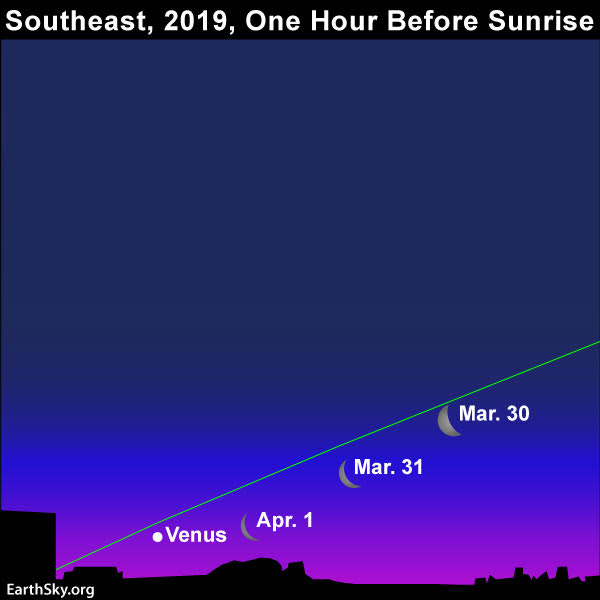Watch for Venus at dawn, Mars at nightfall
Bruce McClure in TONIGHT | March 29, 2019
In late March and early April 2019, the waning crescent moon will be sweeping past the brightest planet, Venus. From mid-northern latitudes in the Northern Hemisphere, the pair will be gracing your eastern sky an hour or so before sunrise. From the Southern Hemisphere, the view is much better, with Venus rising a few hours before the sun.
Even after all the stars have disappeared in the glow of twilight, the moon and Venus will remain visible, because these two worlds rank as the second-brightest and third-brightest celestial luminaries, respectively, after the sun. From far northerly latitudes – like Alaska – you may miss the moon and Venus altogether, as these two worlds rise close to the time of sunrise at northerly climes.
Day by day, as March wanes and April arrives, the moon will sink a little closer to Venus. Not an early riser? Then look for the red planet Mars and the famous Pleiades cluster – also called the Seven Sisters – in your western sky at nightfall, as shown on the chart below. If you see the tiny dipper-shaped Pleiades, you’ll know that’s Mars near it.
All in all, at present, you can catch four of the five bright planets.
Mars is the lone evening planet, but Venus isn’t the only morning planet. The king planet Jupiter – the fourth-brightest celestial body, after the sun, moon and Venus – shines mightily at dawn, as well. From the Northern Hemisphere, Jupiter at morning dawn shines in the southern sky, at about the same spot as the noonday winter sun. At dawn from the Southern Hemisphere, Jupiter shines way up high, like the noonday summer sun.
Saturn is up before the sun also, but it’s much fainter than either Jupiter or Venus. From either hemisphere, you’ll want to catch Saturn before the dawn light becomes too overpowering. At northerly latitudes, because Venus rises relatively late, ringed Saturn might or might not be visible by the time Venus climbs above your horizon.
____________________________________________
At 6:45 AM ET this morning, Venus was tremendously bright and would have been simple for anyone to find in the eastern early morning sky. - ilan
 |
 |
|
|||||||||||
 |
 |
||||||||||||
|
|
|
|
|
|
|
||||||||
 |
|
|
|
|
|
 |
|||||||
|
|
|
|
|||||||||||
|
|
|||||||||||||
|
|
|
|
|
|
|
|
|
|
|
|
|
|
|
Results 1 to 1 of 1
Thread: Venus at dawn, Mars at nightfall
-
03-29-2019, 12:33 PM #1
Venus at dawn, Mars at nightfall
Last edited by ilan; 03-29-2019 at 10:31 PM.
Beginner's Guide for Rocket, NFPS and IKS66...
http://iptvtalk.net/showthread.php?2...-you-should-do
Kodi Options for Rocket, NFPS and IKS66...
http://iptvtalk.net/forumdisplay.php?71-Kodi
Check the Announcement Section...
http://iptvtalk.net/forumdisplay.php...-Announcements
Similar Threads
-
Moon and Venus
By ilan in forum Maps to the StarsReplies: 0Last Post: 02-24-2020, 01:10 PM -
Moon and Venus at dawn
By ilan in forum Maps to the StarsReplies: 0Last Post: 05-30-2019, 12:14 PM -
Moon and 3 planets before dawn
By ilan in forum Maps to the StarsReplies: 0Last Post: 02-26-2019, 01:29 PM -
NASA’s Dawn Spacecraft orbits the Dwarf Planet Ceres
By ilan in forum NASA SpaceX BoeingReplies: 0Last Post: 07-06-2018, 12:07 PM -
Picture of the Day: Dawn's Early Light
By ilan in forum The Universe at a GlanceReplies: 0Last Post: 07-04-2018, 12:19 PM








 Reply With Quote
Reply With Quote